

When you arrive at the little gem of the city of Lucca you should start with a walk on the town walls. But it's no embrasure-armed castle's way but a plane tree-covered park which is curling around the town. There are many gates leading down to the town.

Lucca is of Etruscan descent named after the word Luk = swamp which the little river Serchio deposited and became in 180 BC a Roman colony. It became important in world history when Caesar, Pompeius and Crassus founded in 56 BC the first Triumvirate. Lucca became later the place of the only mint of Tuscany and later gained merchant privilege from Emperor Barbarossa. Especially banker and silk merchants made Lucca one of the richest towns in Europe. The heavy walls around the town made sure it was never conquered, not even by Florence.
The most famous town's son is Giacomo Puccini, born in 1858 whose
birth house is a now a museum.
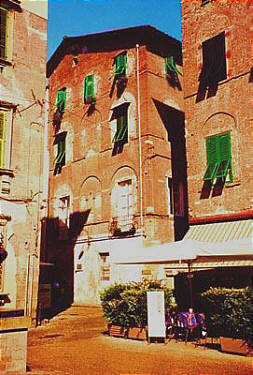
Our first way led to the church of San Michele in Foro. It was built on the site of an antique temple of the Roman Forum whose origins are of the 8th century. There's the golden Madonna in glory on the corner of the facade from 1480 after a plague-epidemic. Upon the roof Saint Michael has just finished killing the dragon. The tower on his back shows the height the citizens of Lucca wanted to built this church. The Greeks called this Hubris, human megalomania and The great plague of 1348 ended these plans.
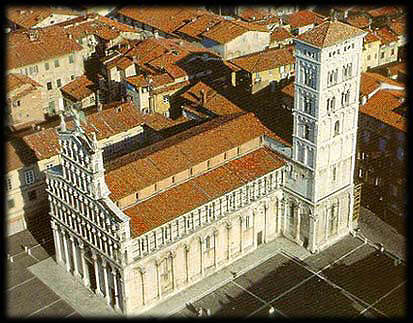
Again you'll be blind when you enter this church. Pure gloomy middle age but I have fallen in love with those gothic and romanic churches ages ago.
You can let drive yourself through the labyrinth of alleys until you come across the former Roman Amphitheatre which is today a half round market place, the flat steps replaced by houses. But all ways lead to the cathedral of San Martino. The first building was erected in 580, the new one started in competition to the Florentine Cathedral, although this one is without a cupola.
The programme of sculptures on the facade is most rich and interesting; it leads from the months and its characteristic farmer's works; the life of Saint Martin to a labyrinth of unknown meaning.
Saint Martin of Tours is sitting upon his horse and splits his cloak with his sword to share it with the beggar. Its meaning for the Romanic sculptures in Tuscany is similar to the meaning of the Bamberg's Rider for Germany (photo). From here it is just a small step to the free-standing sculpture in the tradition of the antique.
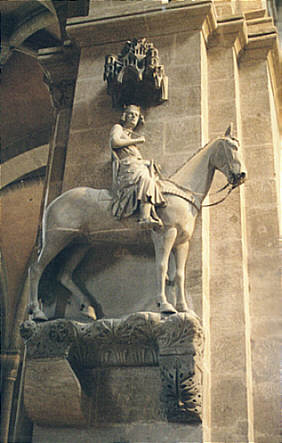 There's a crowd around a small chapel with the Volto Santo. It belongs
to the most adored sanctuary of Italy. It's a crucifix that shows the
face of Jesus shortly after the descent of the cross and it is said
to be carved by Saint Nicodemus from a Lebanon cedar. As the legend
goes the Volto Santo belongs to the so-called "authentic pictures
of Christ". In 782 a pilotless ship brought it to Luni (Italy)
and then an ox-cart without a charioteer straight to Lucca.... or so.
A poor musician received from this crucifix a silver slipper and
later it testified for him who was accused to have stolen it.
So I guess it could speak...
There's a crowd around a small chapel with the Volto Santo. It belongs
to the most adored sanctuary of Italy. It's a crucifix that shows the
face of Jesus shortly after the descent of the cross and it is said
to be carved by Saint Nicodemus from a Lebanon cedar. As the legend
goes the Volto Santo belongs to the so-called "authentic pictures
of Christ". In 782 a pilotless ship brought it to Luni (Italy)
and then an ox-cart without a charioteer straight to Lucca.... or so.
A poor musician received from this crucifix a silver slipper and
later it testified for him who was accused to have stolen it.
So I guess it could speak...
In the middle ages the Volto was most famous. Thus the English King William II vowed "per Vultum de Lucca". Each year in September since 1308 the cross will be carried in a procession through the town.
Do they really believe Jesus looked that old and emaciated? I can't
believe it.
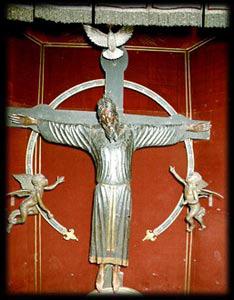
On the right wall hangs a painting by Tintoretto. It hasn't just pretty bright colours it has even a very daring composition. A breastfeeding woman shares the Last Supper. The Venetian Tintoretto: pioneer of female emancipation?
In the left side of the nave was a great jumble. Tourists standing around a sarcophagus with a wooden lying figure. The noise is so great that nobody can understand a word (the tourist's guides are outdoing each other). But you're never helpless when you have yourself a good travel guide. It's the most famous sarcophagus of Ilaria del Carretto, made by Jacopo della Quercia, the well-known son of Siena. Well, Jacob from the Oak tree, we will meet again when we'll visit your hometown tomorrow.
Ilaria del Carretto, who died at aged twenty-six after giving birth to her second child in 1405, was the second wife of Paolo Guinigi, the local merchant tyrant in Lucca. Her tomb, indebted to French precedents, was partially destroyed by the Lucchese in 1430 after Guinigi's expulsion and has been moved at least twice. What remains is a sarcophagus and an effigy, strongly influenced by northern types and courtly costumes - not surprising given Guinigi's commercial links with Burgundy and France. A dog, symbol of fidelity, looks up expectantly at his mistress from her feet. Ilaria seems to be sleeping with her hands over her swollen abdomen to remind us of the cause of her death. Her breasts fall to either side naturalistically, underlying the fact that her flesh is of this world.
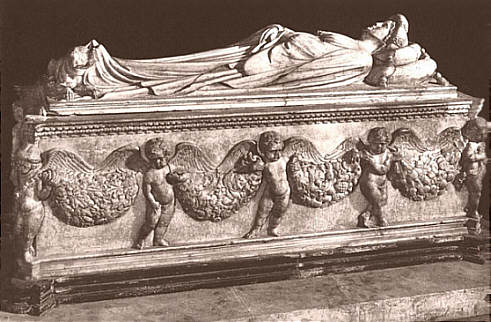 The tower belonging to the house of her husband belongs to Lucca's
symbols, because it can be seen from every place and holm oaks
growing on it.
The tower belonging to the house of her husband belongs to Lucca's
symbols, because it can be seen from every place and holm oaks
growing on it.
Lucca is a quiet town, at least when it's time for siesta, just
several tourist's groups plodding through the streets. For instance
to San Frediano, the church devoted to the Irish pilgrim-monk Fregidianus
who became bishop of Lucca in the 6th century. His bones are still
stored here. The splendid, big mosaic of the facade shines
from afar and is worth alone a visit.
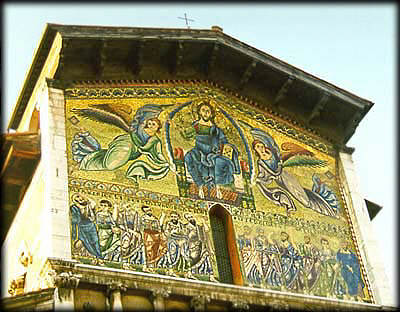
San Frediano has a long nave with lots of side chapels but there's a most mysterious baptismal font whose iconography couldn't be deciphered despite several speculations. It was built in 1150. Next to it, in a chapel, stands a glass coffin with the mummy of Saint Zita, looking like a female puppet in a fancy dress. Some women are placing flowers around it.
When you leave Lucca through one of the gates near San Frediano and climb the walls again, you'll have a great view into the garden of the villa Pfanner-Controni and its geometric garden filled with antique sculptures. It is of course allowed to visit this palazzo, like every villa that surrounds Lucca and they are not less impressive.